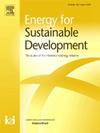应用软链接和地理空间方法优化混合微电网和电网设计:莫桑比克农村环境案例研究
IF 4.9
2区 工程技术
Q2 ENERGY & FUELS
引用次数: 0
摘要
分散的混合可再生能源系统是支持农村发展中地区获得和提供可靠和安全电力服务的成本效益解决方案之一。考虑到目标地区的能源需求和资源不确定性的特殊性,包括技术成本趋势,电气化规划工具对于适当的系统集成至关重要。因此,这项工作提出了一个基于GISEle工具的基于地理空间的综合优化建模框架,该框架除了集成的风能和太阳能能力外,还扩展到水电技术的规模。此外,其程序与两个外部开源评估工具相互关联:水电资源潜力的SWAT模型和能源需求的RAMP模型,以及定制的公开地理空间和基于访谈的数据。新扩展的框架应用于莫桑比克的Majaua-AP案例研究,在两个社区电网空间尺度下对三种不断变化的需求情景进行建模,以规划具有成本效益的电气化战略。分析结果强调,根据项目设置,可以在任何地区确定具有不同人口规模和权力选择值的社区。此外,它还揭示了当地环境对最优网络分配和混合微电网配置设计的最佳技术经济规模的影响。与地面现实相比,网格路由布局显示出很好的近似。对于每个社区,实现了包括柴油+可再生能源(光伏/水电/柴油/电池,光伏/柴油/电池)或100%可再生能源份额(光伏/水电/电池,光伏/电池和水电/电池)的发电系统配置组合。在需求固定和燃料价格高企的情况下,后者更具吸引力;在个别以社区为基础的系统配置中,净当前成本(NPC)为41 - 5384美元(电网扩展)和152 - 22,562美元(发电),而考虑到整个地区,净当前成本为19,156美元(电网扩展)和46,426美元(发电)。电力平准化成本(LCOE)在0.112-0.247美元/千瓦之间。最后,包括水电在内的不断变化的需求使得大多数已安装社区的LCOE大幅降低。本文章由计算机程序翻译,如有差异,请以英文原文为准。
Applying soft-link and geospatial methods for optimal hybrid microgrids and electric network designs: A case study on rural Mozambique settings
Decentralised-based hybrid renewable energy systems represent one of the cost-effective solutions for supporting access to and the provision of reliable and secure electricity services in rural developing regions. Electrification planning tools considering the specificities of targeted areas concerning uncertainties about energy demands and resources, including the technology-cost trends, are essential for proper system integration. This work, therefore, proposes a comprehensive geospatial-based optimisation modelling framework based on GISEle tool, which was expanded to size hydropower technology in addition to its integrated wind and solar capabilities. Moreover, its procedures were interlinked with two external open-source assessment tools: the SWAT model for hydro resource potential and RAMP for energy demand, combined with tailored publicly available geospatial and interview-based data. The newly expanded framework was applied to the Majaua-AP case study in Mozambique by modelling three evolving demand scenarios under two community-grid spatial scales to plan a cost-effective electrification strategy. The analysis results emphasise that communities with differing population sizes, and power pick values can be identified in any region depending on the project settings. Additionally, it revealed that local circumstances influence the best techno-economic sizing regarding optimal network distribution and hybrid microgrid configuration designs. The grid routing layout shows a good approximation compared to ground realities. For each community, a portfolio of generation system configurations including either diesel+renewables (PV/Hydro/diesel/batteries, PV/diesel/batteries) or 100 % renewables share (PV/hydro/batteries, PV/batteries, and hydro/batteries) were achieved. The latter becomes mostly attractive under fixed demand and high fuel price scenarios; among individual community-based system configurations, the net present costs (NPC) range from US$k41–5384 (grid expansion) and US$k152–22,562 (generation) while US$k19,156 (grid expansion) and US$k46,426 (generation) considering the whole region. The levelised costs of electricity (LCOE) ranged from US$/kW 0.112–0.247. Finally, the evolving demand including hydro in the technology mix allowed substantial LCOE reduction in most of the installed communities.
求助全文
通过发布文献求助,成功后即可免费获取论文全文。
去求助
来源期刊

Energy for Sustainable Development
ENERGY & FUELS-ENERGY & FUELS
CiteScore
8.10
自引率
9.10%
发文量
187
审稿时长
6-12 weeks
期刊介绍:
Published on behalf of the International Energy Initiative, Energy for Sustainable Development is the journal for decision makers, managers, consultants, policy makers, planners and researchers in both government and non-government organizations. It publishes original research and reviews about energy in developing countries, sustainable development, energy resources, technologies, policies and interactions.
 求助内容:
求助内容: 应助结果提醒方式:
应助结果提醒方式:


